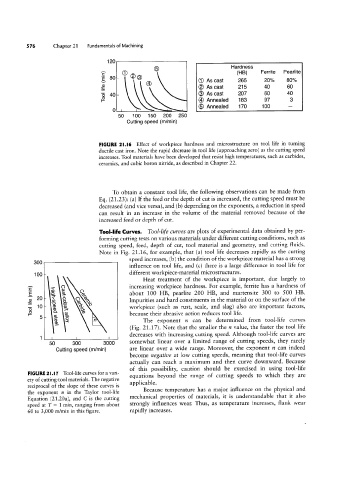Page 595 - 04. Subyek Engineering Materials - Manufacturing, Engineering and Technology SI 6th Edition - Serope Kalpakjian, Stephen Schmid (2009)
P. 595
576 Chapter 21 Fundamentals of Machining
120
(3 Hardness
'E Q) (HB) Ferr|te Pearlite
.
.
V
'E 80 ® ® @ ® As cast 265 20 /0 80 A:
® As cast 215 40 60
:Q
6 40 ® As cast 207 60 40
19 @ Annealed 183 97 3
_*_ © Annealed 170 100 -
O
50 100 150 200 250
Cutting speed (m/min)
FIGURE 2l.l6 Effect of workpiece hardness and microstructure on tool life in turning
ductile cast iron. Note the rapid decrease in tool life (approaching zero) as the cutting speed
increases. Tool materials have been developed that resist high temperatures, such as carbides,
ceramics, and cubic boron nitride, as described in Chapter 22.
To obtain a constant tool life, the following observations can be made from
Eq. (2123): (a) If the feed or the depth of cut is increased, the cutting speed must be
decreased (and vice versa), and (b) depending on the exponents, a reduction in speed
can result in an increase in the volume of the material removed because of the
increased feed or depth of cut.
Tool-life Curves. Tool-life curves are plots of experimental data obtained by per-
forming cutting tests on various materials under different cutting conditions, such as
cutting speed, feed, depth of cut, tool material and geometry, and cutting fluids.
Note in Fig. 21.16, for example, that (a) tool life decreases rapidly as the cutting
speed increases, (b) the condition of the workpiece material has a strong
300
influence on tool life, and (c) there is a large difference in tool life for
100- different workpiece-material microstructures.
Heat treatment of the workpiece is important, due largely to
E :iz O increasing workpiece hardness. For example, ferrite has a hardness of
E Lg 3; QQ about 100 HB, pearlite 200 HB, and martensite 300 to 500 HB.
I 20- cb Q Ca % Impurities and hard constituents in the material or on the surface of the
§ 10- fg if; Yi 6 workpiece (such as rust, scale, and slag) also are important factors,
Q Q S ‘e because their abrasive action reduces tool life.
5- Q
‘Z-"Q
The exponent n can be determined from tool-life curves
Q.
(Fig. 21.17). Note that the smaller the n value, the faster the tool life
decreases with increasing cutting speed. Although tool-life curves are
1 somewhat linear over a limited range of cutting speeds, they rarely
50 300 3000
Cutting speed (m/min) are linear over a wide range. Moreover, the exponent n can indeed
become negative at low cutting speeds, meaning that tool-life curves
actually can reach a maximum and then curve downward. Because
of this possibility, caution should be exercised in using tool-life
FIGURE 2I.I1 Tool-life curves for a vari- equations beyond the range of cutting speeds to which they are
ety of cutting-tool materials. The negative
applicable.
reciprocal of the slope of these curves is Because temperature has a major influence on the physical and
the exponent n in the Taylor tool-life
Equation (21.20a), and C is the cutting mechanical properties of materials, it is understandable that it also
speed at T = 1 min, ranging from about strongly influences wear. Thus, as temperature increases, flank wear
60 to 3,000 m/min in this figure. rapidly increases.

